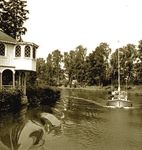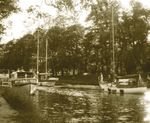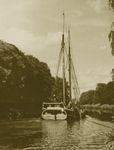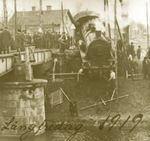A part of Swedish history - The Göta Canal - Sweden's biggest cultural historical construction - Göta kanal
←
→
Page content transcription
If your browser does not render page correctly, please read the page content below
The historical canal Who first hit on the idea of a canal straight across Sweden? Was it legendary king Gustavus Vasa? Or perhaps Sweden’s bishop of the day, Hans Brask? No matter whose the idea originally was, it was to take centuries, and many complicated studies, before the canal was finished. Not until the resourceful Baltzar von Platen came on the scene were the ideas and plans translated into action and the Göta Canal became a reality. I have never been able to regard a map of Sweden without feeling that the mighty waters Mother Nature envelo- ped in this country were made ... to one day provide water transport from coast to coast.” That was how the Göta Canal’s crea- tor, Baltzar von Platen, described the need for a water route through Sweden. The 1780s saw a technological breakthrough that hastened the construction of the Canal. Its designers abandoned the idea of following existing waterways and began building series of locks, grouping them together instead of spreading them out over a long stretch of canal. The opening of the Trollhätte Canal in 1800 showed that large, complex lock and canal constructions were possible, and that modern technology could triumph over mountains, waterfalls and other obstacles in nature. Since 1429, Denmark had demanded a duty for all foreign vessels passing Öresund. One of the strongest arguments for building the Canal was that Swedish merchant and warships needed free passage through the coun- try instead of having to pass Öresund. Construction begins In 1809, Baltzar von Platen and Scot- tish canal builder Thomas Telford presented a detailed plan for a water route through Sweden. An overwhel- ming majority of the parliament voted to build the Göta Canal. One of the fans of the cause was the newly crowned King Carl XIII. He set out the rules for the construction of the Canal in the royal charter that created the Göta Canal Company. Took longer than planned The gargantuan project finally got started. Construction was expected to take ten years, at a cost of 1,597,481 riksdaler. But the calculations were off by far – the Canal took 22 years to build at a cost almost six times the Baltzar von Platen, estimate. The first lock was competed founder of the Göta Canal in Forsvik in 1813, but the entire canal didn’t open for traffic until 1832.
New technology great stubbornness, goal-orientation and The importance of the canal
The canal project covered a large area and focus that created the conditions for the It is a common misconception that the
was carried out by thousands of Swedish project, which would never have been canal was never important to shipping
soldiers. It was gruelling work: all digging completed without him. In an age when because of the rapid growth of the railways.
was done by hand. One rumour has it that Sweden needed new role models and But today we know that the Göta Canal was
the canal was built by Russian prisoners of leaders off the battlefield, von Platen a key transport stretch for at least a
war, but in fact the only Russians involved became a hero of the new era, and one of hundred years. The railway did increase in
were a single company of deserters from the the nation’s first entrepreneurs. importance, but it didn’t take over – rather,
Russian army. it worked with the canal. Not until the
Lock-building technology developed over The grand opening in 1832 1930s and 40s, when the Swedish road
time, in part thanks to experiences of canal- The Västergötland part of the canal was network was improved and the number of
building in Britain. Telford advised von completed in 1822; ten years later the lorries on the roads grew, did land
Platen to hire a number of skilled British whole gigantic project was finished. Ship- transports rob the canal of its importance.
engineers as foremen. Tools were also pers could now travel from Göteborg, via After a few decades of dormancy in the
bought from Britain. In 1822, Baltzar von the Göta Älv River and the Trollhätte Canal, 1950s and 60s, the canal reawakened when
Platen opened a small repair shop in through Lake Vänern, from Sjötorp to it was taken over by leisure boats and
Motala. From this modest start, with just 22 Karlsborg on Lake Vättern, and on from tourism.
employees, the Motala Verkstad grew to Motala to Mem on the east coast. The vision Today the Göta Canal is one of Sweden’s
one of Sweden’s most important industrial of “bringing the seas together” was reached. best known and most popular tourist
facilities, sometimes called the cradle of Baltzar von Platen died in 1829 and never attractions. Alongside boating on the canal,
Swedish industry. Forsvik, on the other side got to see the solemn opening ceremony, “experience tourism” and activities around
of Lake Vättern, was home to one of when the royal yacht Esplendian, with King it have also become well-loved
Sweden’s first technical schools, where Karl XIV Johan on board, was pulled pursuits.
brothers and engineers Nils and John through the last lock at Mem.
Ericsson were key players.
But above all it was Baltzar von Platen’s
From the book "Göta kanal - Den blå vattenvägen genom Sverige" by Willy SvahnThe Göta Canal’s
history in brief
Built: 1810–1832.
Cost: Nine million riksdaler, which corresponds to
about SEK 15.3 billion at 2016 prices.
Labour: 58,000 conscripted soldiers participated,
performing about seven million man-days. A man-day
consisted of 12 hours. The gruelling digging was done
primarily by hand.
Course: Mem at the Baltic to Sjötorp on Lake Vänern.
• 190 km long
• 58 locks
• 50 bridges
• Passes through five lakes
• Highest point 92 m above sea level
AB Göta kanalbolag, Box 3, 591 21 Motala. Tel +46 (0)141 20 20 50. gotakanal.seYou can also read



























































